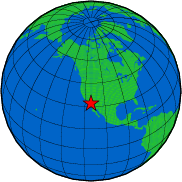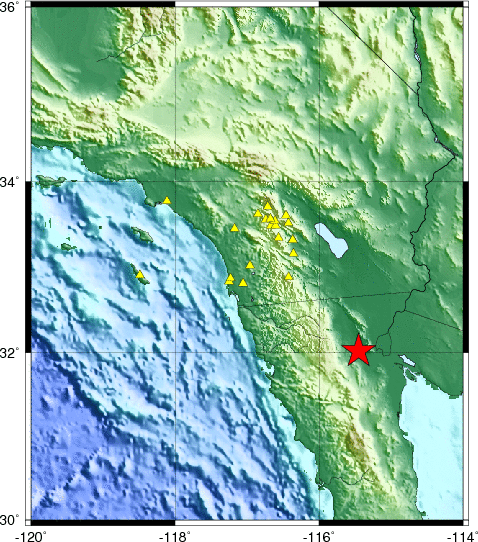Magnitude 4.1 quake near Baja California, Mexico
Last updated: 2018-03-26 (84) 17:50:57 UTC

Quick Links
- Location map
- Initial source parameters
- 3 components [closest Anza station]
- Vertical components [all Anza stations]
- Waveforms recorded at Mt. Soledad
Translations
The Anza group at the University of California San Diego operates a broadband seismograph network consisting of 17 three component broadband seismograph stations centered near Anza, California (see map).
On Wednesday November 28 2007 at 2:49 PM (PST) we recorded an earthquake (preliminary ml 4.1) located near Baja California.
If you have felt this quake, the USGS would like to know. Please add your comments to the USGS page "Did you feel it?".
View the most recent map of local events near San Diego or a slightly wider regional view of events recorded by ANZA, or a map of events recorded by ANZA from around the globe.
Initial source parameters for this tremor are indicated below. The epicentral distance (i.e. the distance separating the epicenter and the closest station in the recording network) for Anza is 133 km (1.20 degrees).
This map shows the mainshock as a red star. Associated aftershocks are orange stars. Anza network stations are yellow triangles. Gray lines are major rivers.
Event Map

Event Parameters
| Latitude | Longitude | Origin time (UTC) | Origin time (PST) | Depth (km) | ml | Author |
|---|---|---|---|---|---|---|
| 32.0215 | -115.4500 | 11/28/07 (332) 22:49.31 | 11/28/07 (332) 2:49 PM | 13 | 4.1 | QED |
* The location and magnitude determined for this event are preliminary and are subject to change upon further review of seismic data.
Notes about the waveforms
On the Anza network, there were very clear crustal arrivals for this event. Typically, P or S means the first arriving P or S phase. In many instances, this first P may not be seen due to its low amplitude arrival and secondary arrivals may be the first observed phase.
After approximately 1-1.5 degrees the P and S phases arrive in the following sequence:
- Pn, Pb, Pg
- Sn, Sb, Sg
Depending on the local geology, the Pb,Pg,Sb,Sg phases may or may not be present. In this event, all three P & S phases are clearly seen.
- Pn, Sn are waves that bottoms out on the Moho and travel at the faster velocity of the material just below the crust.
- Pb, Sb are waves that bottoms out on a mid-crustal velocity layer, commonly known as the Conrad discontinuity.
- Pg, Sg are the direct arriving waves.
Anza is a local network, meaning that it rarely is used to locate events at regional distance where these crustal phases are seen. Consequently, all arrivals are only marked P or S for this catalogue. So have some fun figuring out which of the arrivals are Pn, Pb, Pg, Sn, Sb, Sg!
You may also view a plot showing
Of local interest:
We operate a broadband station on Mt. Soledad. At 14:49 (PST) station SOL recorded the P wave from this event. Here is a view of that event as picked by our analyst. A red P indicates a P wave arrival, a red S indicates an S wave arrival.

View a larger image showing the waveforms recorded at Mt. Soledad.
Visit the IRIS website with additional links to seismic data for this event.
News Links
Search the Internet
To search the internet for more information about this event, click on the button below:
Learn more about the Anza group (including who works
here, other networks, nuclear tests in China/India/Pakistan).
Learn
more about the ANZA network
(includes more station information, research, etc).
